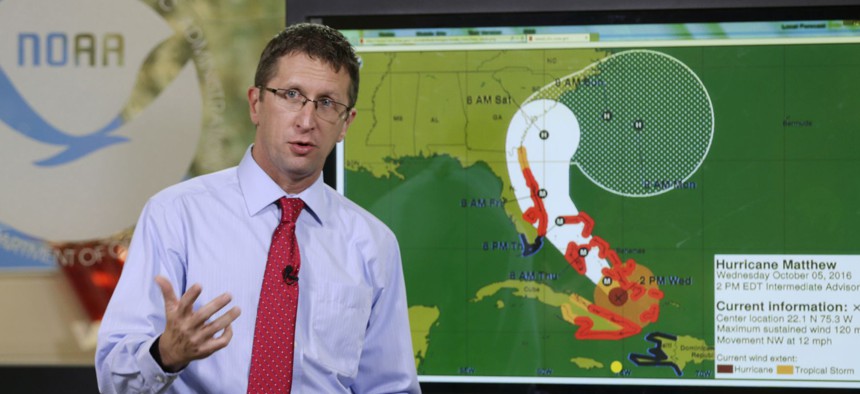Hurricane Matthew to Test Resiliency of Utility and Communications Systems

National Hurricane Center director Rick Knabb speaks during a televised forecast for Hurricane Matthew , Wednesday, Oct. 5, 2016, in Miami. Wilfredo Lee / AP Photo
As utility workers are mobilized to restore service knocked out by the storm, this real-life emergency scenario will test investments in stronger infrastructure and response.
Hurricane Matthew, a Category 3 storm as of Wednesday afternoon, is set to test the resiliency of $2 billion’s worth of electrical grid upgrades made by Florida Power & Light has made to its power-delivery infrastructure since 2006.
The electric utility, which serves 4.6 million customers in Florida primarily along the state’s densely populated Atlantic coast, installed about 75,000 new poles and lines intended to prevent the widespread power outages that came with Hurricane Wilma in 2005. In some parts of the state, outages lasted for more than three weeks.
FPL said while much of its infrastructure can handle 145 mph winds associated with a Category 4 storm, the power-delivery network is still vulnerable to outages caused by downed trees, according to the Sun-Sentinel.
"We're in a significantly better position than we've ever been," Manuel Miranda, FPL’s senior vice president of power delivery, told the Sun-Sentinel. "Our ability to restore [power] is significantly quicker" thanks to the infrastructure upgrades and annual emergency drills built around hurricane scenarios.
All critical infrastructure serving hospitals and first responders has been “hardened,” like feeders routing power from substations to distribution circuits. “Self-healing” substations benefit from 36,000 sensors along power lines—alerting FPL to problems and rerouting power along good lines.
And 6,300 FPL employees will be on hand at staging sites across the service area to restore power.
Similarly, Duke Energy, which is based in Charlotte, North Carolina, placed 1,500 workers on standby across the southeast, reported WFTV. Crews are trained to avoid areas with flooding or downed trees until the storm passes.
Duke’s primary service area includes northwestern South Carolina and much of western North Carolina, where the utility is preparing for major power outages.
"We have a lot of conference calls with our partners at Duke Energy, North Carolina Emergency Management and Wake County," Derrick Remer, Raleigh’s emergency management and special events manager, told WTDV-TV.
Electric utilities from around the region are mobilizing and positioning equipment to help the restoration efforts once the storm passes. A 44-member team from Cleco, which serves customers in central Louisiana, is on its way to southeastern Georgia to lend assistance to Georgia Power and is making 59 contractors available to utilities in Florida, according to KALB-TV in Alexandria, Louisiana.
Beyond restoring power, keeping as much telecommunication infrastructure up and running is a top priority for the disaster response and recovery associated with Hurricane Matthew..
Flooding in and around Baton Rouge, Louisiana, this summer took an AT&T switching station offline temporarily, stopping thousands of people from making phone calls and accessing emails on their mobile devices. First responders and members of Gov. John Bel Edward’s staff lost service in the midst of disaster, and the telecommunications company has a mobile switching facility sent in from out of state to restore service.
With Hurricane Matthew, Verizon announced local network teams will travel to the hardest-hit areas with cells on wheels, cells on light trucks and generators on trailers for extra capacity. The wireless company also beefed up hundreds of cell sites and fortified coverage along evacuation routes while deploying LTE Advanced technology and installing new in-building network systems at hospitals, government and emergency facilities, and popular public venues.
Verizon’s “super-switch” network processing centers—with their hardened exteriors, on-site power generation and backup systems—are designed to withstand Category 5 hurricanes, according to the company.
"Our engineers and technicians are working around the clock preparing emergency services, staging extra equipment and running drills to ensure our customers can rely on us when they need it most," Sergei Mislevy, Verizon’s executive director of network operations, said in a statement.
Dave Nyczepir is a News Editor at Government Executive’s Route Fifty and is based in Washington D.C.
NEXT STORY: Car Privileges Revoked for Some Mass. State Workers; Big Jump in St. Louis’ Foreign-Born Residents






